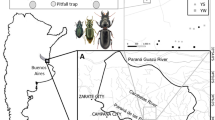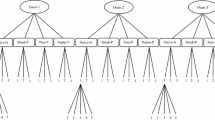Abstract
In shrubland ecosystems, shrubs as ecosystem engineers play an important role in structuring ground beetle communities. However, the influence of shrub vegetation on the distribution and diversity of ground beetles remains unknown in Gobi desert, northwest China, where shrubland is a major biome type. Using Gobi shrubland dominated by shrub species Nitraria sphaerocarpa and Reaumuria soongorica as a model system, we sampled ground beetle communities using a pitfall trapping method under canopies of both shrubs and in intershrub bare areas during spring, summer and autumn corresponding to the main period of beetle activity. Simultaneously, physical environment of the three microhabitats and plant characteristics of both shrubs were measured. We determined whether shrubs and species identity influence ground beetle distribution and diversity patterns and whether the response of beetles to the presence and species of shrubs is consistent across species. At the community level, total beetle abundance and species richness were significantly greater under shrubs than in intershrub bare areas, whereas more beetles were captured under N. sphaerocarpa than under R. soongorica. At the population level, eight dominant beetle species responded differently to the presence and species of shrubs. The abundance of Anatolica sp., Carabus sp., Cyphogenia chinensis, Microdera sp. and Sternoplax setosa was consistently much greater under shrubs than in intershrub bare areas, whereas the abundance of Blaps gobiensis, Lethrus apterus and Pterocoma reitteri under shrubs was similar to that in intershrub bare areas. The shrub N. sphaerocarpa was commonly preferred by Anatolica sp., C. chinensis and S. setosa, whereas the shrub R. soongorica was commonly preferred by L. apterus, but the abundance of B. gobiensis, Carabus sp., Microdera sp. and P. reitteri was unaffected by shrub species. Differences in the abundance, species richness and composition of ground beetles among microhabitat types were largely related to among-microhabitat differences in the physical environment and resource availability. Our results suggest that shrubs and species identity play key roles in structuring ground beetle communities, but their influence differed between species. This study emphasizes the importance of protecting shrub habitats for the maintenances of beetle biodiversity in this Gobi desert ecosystem.





Similar content being viewed by others
References
Alpert P, Mooney HA (1996) Resource heterogeneity generated by shrubs and topography on coastal sand dunes. Vegetatio 122:83–93
Antvogel H, Bonn A (2001) Environmental parameters and microspatial distribution of insects: a case study of carabids in an alluvial forest. Ecography 24:470–482
Barber NA, Marquis RJ (2011) Leaf quality, predators, and stochastic processes in the assembly of a diversity herbivore community. Ecology 92:699–708
Barth RC, Klemmedson JO (1978) Shrub-induced spatial variation of dry matter, nitrogen, and organic carbon. Soil Sci Soc Am J 64:635–639
Begon M, Townsend CR, Harper JL (2006) Ecology: from individuals to ecosystems, 4th edn. Blackwell, Malden
Bezemer TM, Fountain MT, Barea JM, Christensen S, Dekker S, Duyts H, van Hal R, Harvey JA, Hedlund K, Maraun M, Mikola J, Mladenov AG, Robin C, de Ruiter P, Scheu S, Setälä H, Šmilauer P, van der Putten WH (2010) Divergent composition but similar function of soil food webs beneath individual plants: plant species and community effects. Ecology 91:3027–3036
Callaway RM (1992) Effect of shrubs on recruitment of Quercus douglasii and Quercus lobata in California. Ecology 73:2118–2128
Charley JL, West NE (1975) Plant-induced soil chemical patterns in some shrub dominated semi-desert ecosystems of Utah. J Ecol 63:945–963
Chen LH, Li FX (1998) Aeolian sandy soil in China. Science Press, Beijing (in Chinese)
Cushman JH, Waller JC, Hoak DR (2010) Shrubs as ecosystem engineers in a coastal dune: influences on plant populations, communities and ecosystems. J Veg Sci 21:821–831
Doblas-Miranda E, Sánchez-Pinero F, Gonzalez-Megías A (2007) Soil macroinvertebrate fauna of a Mediterranean arid system: composition and temporal changes in the assemblage. Soil Biol Biochem 39:1916–1925
Doblas-Miranda E, Sánchez-Pinero F, Gonzalez-Megías A (2009) Different microhabitats affect soil macroinvertebrate assemblages in a Mediterranean arid ecosystem. Appl Soil Ecol 41:329–335
Facelli JM, Temby AM (2002) Multiple effects of shrubs on annual plant communities in arid lands of South Australia. Aust Ecol 27:422–432
Garner W, Steinberger Y (1989) A proposed mechanism for the formation of ‘fertile islands’ in the desert ecosystem. J Arid Environ 16:257–262
Gutiérrez JR, Meserve PL, Contreras LC, Vásquez H, Jaksic FM (1993) Spatial distribution of soil nutrients and ephemeral plants underneath and outside the canopy of Porlieria chilensis shrubs (Zygophyllaceae) in arid coastal Chile. Oecologia 95:347–352
Haworth K, McPherson GR (1995) Effects of Quercus emoryi on precipitation distribution and microclimate in a semi-arid savanna. J Arid Environ 31:153–170
Lepš J, Šmilauer P (2003) Multivariate analysis of ecological data using CANOCO. Cambridge University Press, Cambridge
Li FR (2008) Presence of shrubs influences the spatial pattern of soil seed banks in desert herbaceous vegetation. J Veg Sci 20:847–859
Li XY, Liu LY, Gao SY, Ma YJ, Yang ZP (2008) Stemflow in three shrubs and its effect on soil water enhancement in semiarid loess region of China. Agric Forest Meteorol 148:1501–1507
Li FR, Zhao WZ, Kang LF, Liu JL, Huang ZG (2009a) Seed distribution of four co-occurring grasses around Artemisia halodendron shrubs in a sandy habitat. Acta Oecol 35:444–451
Li FR, Zhao WZ, Liu JL, Huang ZG (2009b) Degraded vegetation and wind erosion influence soil carbon, nitrogen and phosphorus accumulation in sandy grasslands. Plant Soil 317:79–92
Li X, Li XW, Li ZY, Ma MG, Wang J, Xiao Q, Liu Q, Che T, Chen EX, Yan GJ, Hu ZY, Zhang LX, Chu RZ, Su PX, Liu QH, Liu SM, Wang JD, Niu Z, Chen Y, Jin R, Wang WZ, Ran YH, Xin XZ, Ren HZ (2009c) Watershed allied telemetry experimental research. J Geophys Res 114:D22103. doi:10.1029/2008JD011590
Liu GR, Zhang YR, Wang R (1997) The colour illustrated of common lamellicornia beetles of northern China. China Forestry Publishing House, Beijing (in Chinese)
Liu JL, Li FR, Liu QJ, Niu RX (2010) Seasonal variation in soil fauna community composition and diversity in an arid desert ecosystem of the Heihe basin. J Desert Res 30:342–349 (in Chinese with English abstract)
Liu RT, Zhao HL, Zhao XY, Drake S (2011) Facilitative effects of shrubs in shifting sand on soil macro-faunal community in Horqin sand land of inner Mongolia, northern China. Euro J Soil Biol 47:316–321
López-Pintor A, Gómez Sal A, Benayas JMR (2006) Shrubs as a source of spatial heterogeneity: the case of Retama sphaerocarpa in Mediterranean pasture of central Spain. Acta Oecol 29:247–255
Lövei GL, Sunderland KD (1996) Ecology and behavior of ground beetles (Coleoptera: Carabidae). Annu Rev Entomol 41:231–256
Maestre FT, Cortina J (2005) Remnant shrubs in Mediterranean semi-arid steppes: effects of shrub size, abiotic factors and species identity on understorey richness and occurrence. Acta Oecol 27:161–169
Mazía CN, Chaneton EJ, Kitzberger T (2006) Small-scale habitat use and assemblage structure of 6 ground-dwelling beetles in a Patagonian shrub steppe. J Arid Environ 67:177–194
Milcu A, Partsch S, Langel R, Scheu S (2006) The response of decomposers (earthworms, springtails and microorganisms) to variations in species and functional group diversity of plants. Oikos 112:513–524
Moro MJ, Pugnaire FI, Haase P, Puigdefábregas J (1997) Effect of the canopy of Retama sphaerocarpa on its understorey in a semi-arid environment. Funct Ecol 11:425–431
Mueller-Dombois D, Ellenberg H (1974) Aims and methods of vegetation ecology. Wiley, New York
Parmenter RR, Parmenter CA, Cheney CD (1989) Factors influencing microhabitat partitioning among coexisting species of arid-land darkling beetles (Tenebrionidae): behavioral responses to vegetation architecture. Southwest Nat 34:319–329
Pen-Mouratov S, Rakhimbaev M, Barness G, Steinberger Y (2004) Spatial and temperal dynamics of nematode populations under Zygophyllum dumosum in arid environments. Eur J Soil Biol 40:31–46
Peterson AC, Hendrix PF, Haydu C, Graham RC, Quideau SA (2001) Single-shrub influence on earthworms and soil macroarthropods in the southern California chaparral. Pedobiologia 45:509–522
Polis GA (1991) The ecology of desert communities. The University of Arizona Press, Tucson
Pugnaire FI, Lázaro R (2000) Seed bank and understorey composition in a semi-arid environment: the effect of shrub age and rainfall. Ann Bot 86:807–813
Ren GD, Yu YZ (1999) The darkling beetles from deserts and semideserts of China (Coleoptera: Tenebrionidae). Hebei University Publishing House, Baoding (in Chinese)
Richman DB, Huddleston EW, Ortiz M (1982) Seasonal activity of tenebrionid beetles in New Mexico mesquite dunes. Southwest Nat 27:305–308
Rogers LE, Woodley NE, Sheldon JK, Beedlow PA (1988) Diets of darkling beetles (Coleoptera: Tenebrionidae) within a shrub-steppe ecosystem. Ann Entomol Soc Am 81:782–791
Rosagno CM, del Valle HF, Videla L (1991) The influence of shrubs on some chemical and physical properties of an aridic soil in north-eastern Patagonia, Argentina. J Arid Environ 20:179–188
Sackmann P, Flores GE (2009) Temporal and spatial patterns of tenebrionid beetle diversity in NW Patagonia, Argentina. J Arid Environ 73:1095–1102
Shachak M, Boeken B, Groner E, Kadmon R, Lubin Y, Ne’Eman G, Perevolotsky A, Shkedy Y, Ungar ED (2008) Woody species as landscape modulators and their effects on biodiversity patterns. Bioscience 58:209–221
Shumway SW (2000) Facilitative effects of a sand dune shrub on species growing beneath the shrub canopy. Oecologia 124:138–148
Stapp P (1997) Microhabitat use and community structure of darkling beetles (Coleoptera: Tenebrionidae) in shortgrass prairie: effects of season, shrub cover and soil type. Am Midl Nat 137:298–311
Su YZ, Zhao HL, Li YL, Cui JY (2004) Influencing mechanisms of several shrubs on soil chemical properties in semiarid Horqin sandy land, China. Arid Land Res Manag 18:1–13
Sylvain ZA, Wall DH (2011) Linking soil biodiversity and vegetation: implications for a changing planet. Am J Bot 98:517–527
Tews J, Brose U, Grimm V, Tielbörger K, Wichmann MC, Schwager M, Jeltsch F (2004) Animal species diversity driven by habitat heterogeneity/diversity: the importance of keystone structures. J Biogeogr 31:79–92
Titus JH, Nowak RS, Smith SD (2002) Soil resource heterogeneity in the Mojave Desert. J Arid Environ 52:269–292
Vetaas OR (1992) Micro-site effects of trees and shrubs in dry savannas. J Veg Sci 3:337–344
Wang XP, Wang ZN, Berndtsson R, Zhang YF, Pan YX (2011) Desert shrub stemflow and its significance in soil moisture replenishment. Hydrol Earth Syst Sci 15:561–567
Wardle DA (2002) Communities and ecosystems: linking the aboveground and belowground components. Princeton University Press, Princeton and Oxford
Wardle DA, Bardgett RD, Klironomos JN, Setälä H, van der Putten WH, Wall DH (2004) Ecological linkages between aboveground and belowground biota. Science 304:1629–1633
Wilder SM, Holway DA, Suarez AV, Eubanks MD (2011) Macronutrient content of plant-based food affects growth of a carnivorous arthropod. Ecology 92:325–332
Wise DH (1981) Seasonal and yearly patterns in the densities of darkling beetles (Goleoptera: Tenebrionidae) in a montane community. Environ Entomol 10:350–358
Zhou ZY, Chen SK, Fu H (1990) Studies on primary nutritive types in Alisha desert grasslands. Gansu Science and Technology Press, Lanzhou (in Chinese)
Zhou ZY, Zhu ZY, Liu ZL (2010) Restoration of degraded arid desert ecosystems and sustainable development. Science Press, Beijing (in Chinese)
Zhou ZY, Li FR, Chen SK, Zhang HR, Li G (2011) Dynamics of vegetation and soil carbon and nitrogen accumulation over 26 years under controlled grazing in a desert shrubland. Plant Soil 341:257–268
Ziesche TM, Roth M (2008) Influence of environmental parameters on small scale distribution of soil dwelling spiders in forests: what makes the difference, tree species or microhabitat? Forest Ecol Manag 255:738–752
Zotov VA, Alpatov AM (2005) Adaptive significance of the circadian rhythm of activity in Omniseasonal desert beetles (Coleoptera, Tenebrionidae). Entomol Rev 85:357–360
Acknowledgments
We thank two anonymous referees for their useful comments and suggestions on the manuscript. We also thank all technicians for help with the field investigation. This study was supported by the National Natural Science Foundation of China (31170496 and 91025021) and by the National Science Foundation for Distinguished Young Scholars of China (41125002).
Author information
Authors and Affiliations
Corresponding author
Rights and permissions
About this article
Cite this article
Liu, JL., Li, FR., Liu, CA. et al. Influences of shrub vegetation on distribution and diversity of a ground beetle community in a Gobi desert ecosystem. Biodivers Conserv 21, 2601–2619 (2012). https://doi.org/10.1007/s10531-012-0320-4
Received:
Accepted:
Published:
Issue Date:
DOI: https://doi.org/10.1007/s10531-012-0320-4





